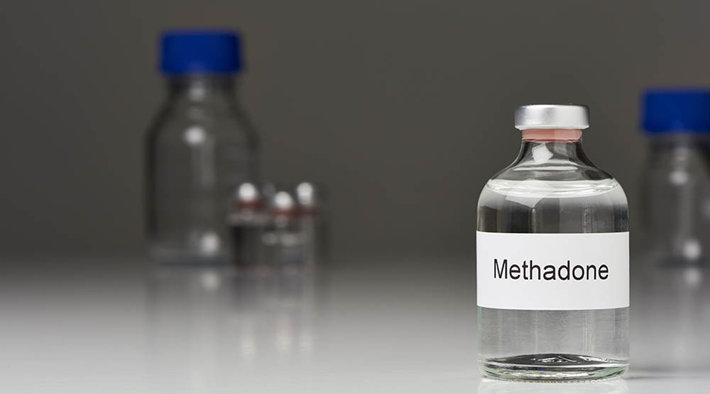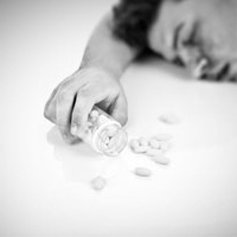Methadone Addiction

Where did Methadone Come From?
Methadone Hydrochloride is an opioid (a synthetic opiate) that was originally synthesized by German pharmaceutical companies during the Second World War.
Methadone was first marketed as ‘Dolophine’ and was used as an analgesic (a painkiller) for the treatment of severe pain. It is still occasionally used for pain relief.
Methadone is now primarily used today as a substitute drug for heroin and other opioid addictions. The effects of methadone are longer-lasting than those of morphine-based drugs. Methadone’s effects can last up to 24 hours, thereby permitting administration only once a day in heroin addiction maintenance programs.
How is Methadone Taken?
Methadone is usually available as a liquid - linctus or methadone mixture - which should be swallowed. Tablets and injectable ampoules are sometimes prescribed, and like many other medicines some of these prescribed drugs are diverted and become available illegally.
What are Methadone’s Adverse Reactions?
Deaths occur more frequently at the beginning of treatment in methadone programs; they are usually a cause of excessive doses (i.e. erroneously estimated tolerance) and they are affected by concomitant diseases (hepatitis, pneumonia). Overdose can also occur when a user attempts to supplement his methadone dose with heroin or other drugs. Methadone generally entails the entire spectrum of opioid side effects, including the development of tolerance and physical and psychological dependence. Respiratory depressions are dangerous. The released histamines can cause hypotension or bronchospasms. Other symptoms are: constipation, nausea or vomiting, sedation, vertigo, edema.
What are the Symptoms of Methadone Overdose?
Body as a whole:
- muscle spasticity
Respiratory problems:
- difficulty breathing
- slow, shallow and labored breathing
- stopped breathing (sometimes fatal within 2-4 hours)
Eyes, ears, nose, and throat:
- pinpoint pupils
- bluish skin
- bluish fingernails and lips
Gastrointestinal:
- spasms of the stomach and/or intestinal tract
- constipation
Heart and blood vessels:
- weak pulse
- low blood pressure
Nervous system
- drowsiness
- disorientation
- coma
What is Methadone Dependency?
As an opioid, regular use of methadone causes physical dependency - if you’ve been using it regularly (prescribed or not) once you stop you will experience a withdrawal. The physical changes due to the drug are similar to other opiates (like heroin); suppressed cough reflex, contracted pupils, drowsiness, and constipation. Some methadone users feel sick when they first use the drug. If you are a woman using methadone you may not have regular periods - but you are still able to conceive. Methadone is a long-acting opioid; it has an effect for up to 36 hours (if you are using methadone you will not withdraw for this period) and can remain active in your system for several days.

Personal Stories of Methadone Withdrawal:
“I’ve been on both ends of withdrawals, heroin and methadone, every patient of methadone will always tell you the same, as I do; I can kick heroin anytime, but methadone that is something else. In 15 yrs of heroin addiction, I’ve kicked 3 times, ‘cold-turkey’. In 10 years on methadone I’ve never kicked methadone.”
Once I landed in jail, I had to do 72 hours of jail time before I got to see the judge. I was literally on the floor screaming my guts out. About 12 hours before I was to see the judge, I demanded to be taken to the hospital, I just couldn’t take it. I was cuffed, and looking like a ‘chair’ was glued to my back, I limped to the ambulance since I couldn’t lift my leg to climb into the back, the police grabbed me on both sides and shoved me in like a sack of potatoes, I fell flat on my face. The doctor realizing my condition and that it was severe, gave me a shot of methadone. The relief was immediate.
I was returned to the precinct and 2 days later I was in the same condition! Never did I go through such hell in all my days.
The intensity of methadone withdrawal is just too much! I could never do it. By the way, about 5 years ago one inmate went into convulsions and upon falling, he hit the metal bars and died.
On Sunday morning, March 30, I took my last dose of methadone. I had been on 80 mgs of methadone for the past 6 months.
My doctor, an anesthesiologist, writes prescriptions for 125 tablets. This lasts 15 days. I signed a contract with him that basically says I will use the same pharmacy, I will not get meds from other physicians, and if I run out before the 15 days is up I just have to go without. I didn’t mind signing the contract at all, and I have abided by all the stipulations. I called him for a refill on Friday. No response. I called again on Saturday. No response. I called his home on Sunday. No response. On Sunday I took my last dose. I hate anything having this much control over me. I find it very demeaning to be so dependent on a bottle of pills.
On Monday I called his office. They informed me that he was on vacation this week. Panic descended… and so did withdrawal symptoms. At first, I just got kinda nervous, jittery. My doctor has told me that methadone is not addicting. That is contrary to everything and anything I’ve ever heard or read about the drug. I never questioned him why he thought methadone wasn’t addicting. I was hoping I’d never have to find out. What my body went through for the next 48 hours was one severe blow after another. I kept trying to tell myself I just had the flu. Just crawl in bed for three days and sweat it out. Of course, I knew this wasn’t true but I was going to play whatever mind game it took to get me through this. After the jitters, the muscle contractures started. It felt like the muscles in my legs and then in my arms were like rubber bands, being stretched and pulled to their max and then constricting to a shape that wasn’t natural. Then came the sweats, diarrhea, hallucinations.
I remember trying to dial the phone. It was a number I’ve called a thousand times before, only now I couldn’t remember it. For that matter, I couldn’t even hold the phone… I kept dropping it. My muscles were out of control. The pain that led me to methadone returned with a vengeance. In a strange way, it was like an old friend. I knew it well and understood it completely. The combination of withdrawal and pain was too much. The all too familiar thoughts of suicide were returning.
It was now Tuesday morning. I called the pharmacist and explained the situation. By 1:10 PM I had eight methadone tablets. I took the entire dose at once all eight tablets. Within two hours my muscles had stopped screaming, my head was beginning to clear, and the pain was lessening.
It’s now Thursday morning. I’m still not back to myself… but much better. The assault on my body was indeed very traumatic… I lost 7 pounds and am still very shaky. Addiction is indeed a dangerous thing and should be avoided. I must admit when I was in the throes of withdrawal there’s not much I wouldn’t have done to relieve the symptoms.
What are the Dangers of Methadone?
Following is an article by two doctors addressing this question.
Is Methadone More Likely to Kill You than Heroin?
By Drs. Marcel Buster & Giel van Brussel, MD
Municipal Health Service Amsterdam
Based on literature and analysis of mortality figures, Dr. Russell Newcombe concluded that methadone programs as a form of harm-reduction possibly cause more victims than they prevent. We have doubts whether the conclusion about methadone is fully justified. Looking at the mentioned literature gives a one-sided view of the problem. Moreover, the conclusions drawn are beyond those justified by the results of the analyses. Several points of debate come to mind:
Methadone is not an innocent substance; ‘one’s methadone maintenance dose is another’s poison’ (2). A regular user of opiates develops a certain tolerance. Therefore, it is possible that a tolerant person can function normally with dosages which can be fatal to a non-tolerant person. Also, methadone dosage in the case of first entry to the program has to be evaluated carefully. It is wise to begin with a low dosage that has to be increased slowly in the course of weeks or even months. At entry to the program, it has to be carefully evaluated whether a patient has a clear and unambiguous heroin dependence. In methadone maintenance programs, methadone is dispensed to tolerant persons, moreover, this tolerance remains high because of daily use of methadone. Therefore, it is not surprising that deaths at the King’s College Hospital caused by methadone were not those of participants of a methadone maintenance program but were those of ‘recreational’ users of illicit methadone.

In cases where more than one drug is used, the drug responsible for death due to overdose is difficult to establish. Moreover, the same drug prescribed by physicians can also be bought on the street. In seventy percent of the deaths due to overdose studied in Glasgow and Edinburgh, a combination of different drugs was found (3).
Prescribed drugs such as temazepam were often encountered in deaths in Glasgow. However, among only 14 of the 34 persons who died in 1992 and where temazepam was found, this was prescribed by their physician. Because of the presence of other drugs, it is not clear whether temazepam really caused the death of these people. Probably the combination of these different drugs was fatal to them. This was also the case with the methadone deaths in Edinburgh. However, in Edinburgh, the authors could not determine whether methadone was prescribed or not. Both Hammersley and Obafunwa report that heroin/morphine deaths seldom occur in Edinburgh (4). ‘The fall of the deaths due to overdose in the Lothian and Borders Region of Scotland (LBRS) after 1984 reflects in part the strict policing that took place, in particular in the Edinburgh area’.
‘The increase of methadone deaths is probably due to the introduction of a street trend to use this agent as a substitute to heroin’. The author suggests that methadone deaths are mainly caused by the use of illicit methadone.
Therefore, these figures suggest that participants of methadone programs are at lower risk of death due to overdose. However, this does not mean that methadone is an innocent substance. The high and increasing number of methadone deaths in Britain is alarming and certainly needs more attention. The first priority should be to establish whether the methadone causing death has been prescribed within a methadone program or bought on the street. It also should be evaluated at what point during the course of the methadone program death takes place. Further instruction doctors prescribing methadone could be necessary. The use of non-prescribed methadone without medical supervision can lead to high risks, especially when it is used as a substitute for heroin in order to get a ‘high’ instead of to prevent withdrawal symptoms. Physicians have to be aware of this danger and they should make sure that the prescribed methadone (as well as other psychoactive drugs) does not end up in the ‘gray market’.
Heroin / Methadone information presented by Narconon International. See also: Heroin Addiction | History of Heroin | Heroin Drug Info | Heroin Timeline
 ®
®